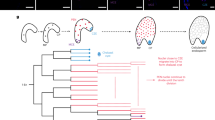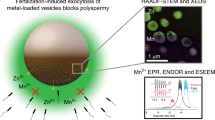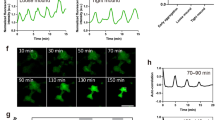Abstract
Cytosolic free calcium has recently been implicated in the regulation of mitosis in plant and animal cells1–8. We have previously found correlations between increases in the levels of intracellular free calcium [Ca2+]i and visible transitions of structure at nuclear envelope breakdown (NEBD) and the onset of anaphase during mitosis in sea urchin embryos and tissue culture cells7,8. To go beyond correlations it is necessary to manipulate [Ca2+]i, and in sea urchin embryos this requires the injection of calcium-chelator buffer solutions as the changes in free calcium in the cell cycle are dependent on intracellular stores7,9. We report here that blocking the increase in [Ca2+li which just precedes NEBD prevents this from taking place and halts mitosis. Subsequent injections which momentarily increase [Ca2+]i, or a natural recovery of the higher calcium levels, result in NEBD and the successful continuation of mitosis. Similarly, artificially increasing calcium by early injections results in early NEBD. We conclude that the increase in [Ca2+]i> preceding NEBD is an essential regulatory step required for entry into mitosis.
This is a preview of subscription content, access via your institution
Access options
Subscribe to this journal
Receive 51 print issues and online access
$199.00 per year
only $3.90 per issue
Buy this article
- Purchase on Springer Link
- Instant access to full article PDF
Prices may be subject to local taxes which are calculated during checkout
Similar content being viewed by others
References
Hepler, P. K. J. cell Biol. 100, 1363–1368 (1985).
Keith, C. H., Ratan, R., Maxfield, F. R., Baer, A. & Shelanski, M. L. Nature 316, 848–850 (1985).
Ratan, R., Shelanski, M. L. & Maxfield, F. R. Proc. natn. Acad. Sci. U.S.A. 83, 5136–5140 (1986).
Wolniak, S. K., Hepler, P. K. & Jackson, W. T. J. cell Biol. 96, 598–605 (1983).
Wolniak, S. M. & Bart, K. M. Eur. J. cell Biol. 39, 273–277 (1986).
Poenie, M. & Steinhardt, R. A. in Calcium and Cell Function Vol. 7 (ed. Cheung, W. Y.) 133–157 (Academic, New York, 1987).
Poenie, M., Alderton, J., Tsien, R. Y. & Steinhardt, R. A. Nature 315, 147–149 (1985).
Poenie, M., Alderton, J., Steinhardt, R. & Tsien, R. Science 233, 886–889 (1986).
Chambers, E. L. Eur. J. cell Biol. 22, 476 (1980).
Martell, A. E. & Smith, R. M. Critical Stability Constants (Plenum, London, 1974).
Tsien, R. Y. Biochemistry 19, 2396–2404 (1980).
Arslan, P., Di Virgilio, F., Beltrame, M. & Tsien, R. Y. J. Biol. Chem. 260, 2719–2727 (1985).
Baker, P. F. & Warner, A. E. J. cell Biol. 53, 579–581 (1972).
Grynkiewicz, G., Poenie, M. & Tsien, R. Y. J. biol. Chem. 260, 3440–3450 (1985).
Author information
Authors and Affiliations
Rights and permissions
About this article
Cite this article
Steinhardt, R., Alderton, J. Intracellular free calcium rise triggers nuclear envelope breakdown in the sea urchin embryo. Nature 332, 364–366 (1988). https://doi.org/10.1038/332364a0
Received:
Accepted:
Issue Date:
DOI: https://doi.org/10.1038/332364a0
This article is cited by
-
Incorporation of Functionalized Calcium Phosphate Nanoparticles in Living Cells
Journal of Cluster Science (2022)
-
LEFTY2 inhibits endometrial receptivity by downregulating Orai1 expression and store-operated Ca2+ entry
Journal of Molecular Medicine (2018)
-
T-type calcium channel antagonists, mibefradil and NNC-55-0396 inhibit cell proliferation and induce cell apoptosis in leukemia cell lines
Journal of Experimental & Clinical Cancer Research (2015)
-
Kv3.4 potassium channel-mediated electrosignaling controls cell cycle and survival of irradiated leukemia cells
Pflügers Archiv - European Journal of Physiology (2013)
-
Boric acid inhibits stored Ca2+ release in DU-145 prostate cancer cells
Cell Biology and Toxicology (2009)
Comments
By submitting a comment you agree to abide by our Terms and Community Guidelines. If you find something abusive or that does not comply with our terms or guidelines please flag it as inappropriate.



